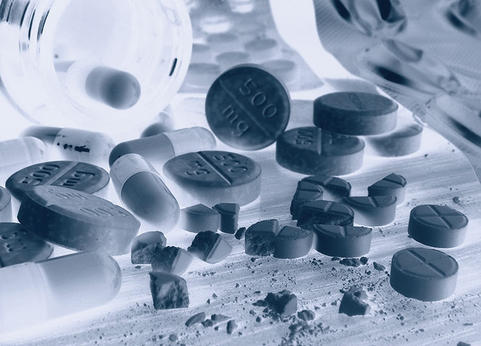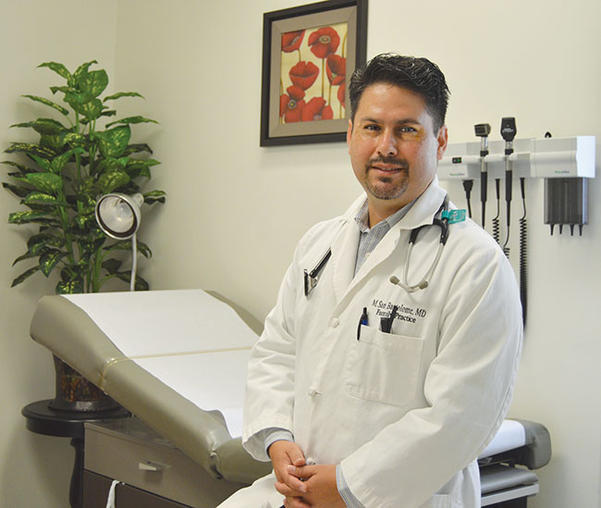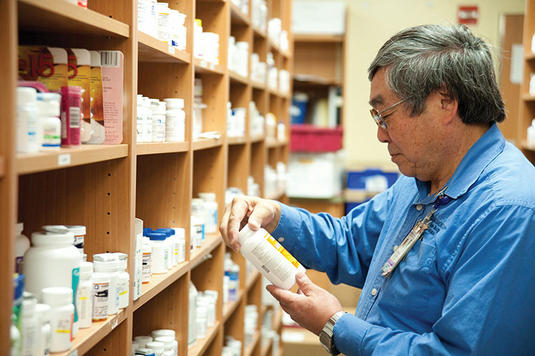Between 2008 and 2013, more than 14 million prescriptions for opioids, or pain relievers, were issued in Los Angeles County, according to a 2013 L.A. County Department of Public Health study. The National Institute on Drug Abuse (NIDA) reported that 52 million people in the United States over the age of 12 have used prescription drugs for nonmedical reasons at least once and that 54% of prescription drugs are obtained from a friend or relative.
With so many pills and medications floating around L.A. County and the country in general, it’s easy to see how a prescription drug addiction crisis could slowly begin to take its toll on the U.S.

NIDA reports that, while it only makes up 5% of the world’s population, the U.S. consumes 75% of the world’s prescription medication. Also, the Centers for Disease Control & Prevention claimed that 2014 saw more drug overdoses than any year on record. About half of those deaths were from prescription drugs.
“For a long time, we were focused on the war on drugs, but it was about drugs like marijuana or cocaine, narcotics that were coming into the country illegally,” Dr. J. Mario Molina, M.D., president and chief executive officer of Molina Healthcare, said. “Now we see a shift where more and more people are getting their hands on drugs that are prescribed legally here in the United States. That gets around the issue of someone having to import the drugs illegally – they’re already here.”
With the dramatic rise in the number of prescriptions over the last couple of decades, the country has also seen a drastic rise in dependency and addiction to these drugs. To combat the prescription drug epidemic, dependency and addiction must first be understood.
According to Molina, dependence on a drug is physical. A person takes the drug to feel normal physically; if they stop, they may suffer from withdrawals that cause them physical pain. Addiction, on the other hand, has a psychological aspect that must be dealt with, as it pertains to the addict’s ability to make life choices.
“People throw the word addiction around fairly loosely, but to an addiction specialist it means something quite specific,” Dr. Mario San Bartolome, the founding physician of the Addiction Medicine Program at Community Hospital Long Beach, said. “It involves particular nerve pathways and neurocircuits in the brain that involve emotion memory and the prefrontal cortex which controls judgment. This explains how addiction manifests as behavior and why it’s so difficult for people to wrap their heads around – because it’s not logical.”
Some of the most commonly abused drugs are narcotic pain relievers, such as Vicodin and OxyContin, Molina said. Both are very effective – Vicodin for short-term pain and discomfort and OxyContin for long-term, chronic pain. However, Molina points out that OxyContin has received so much media attention because people are using it in place of heroin.
“If you look at the top five drugs prescribed in Medicaid programs, Vicodin or a Vicodin-like drug is almost always in the top five in terms of the frequency of prescription,” Molina said. “It’s prescribed an awful lot. But there are a lot of non-addictive drugs: ibuprofen, which is Motrin, naproxen, which is Aleve. These are drugs that you can buy over the counter and they are pretty effective.”
Unfortunately, Molina said that these more potent narcotic options have been around for a long time and are reliable and effective, which means doctors are more apt to prescribe them in the current era of immediacy.
With modern technology, people are always looking for the quickest satisfaction – high-speed Internet, fast food, instant results. This mentality carries over to medicine, according to San Bartolome. He said this cultural shift means there is an expectation by patients that their pain will be alleviated instantly. He added that due to this attitude, about 20 years ago hospitals saw a big push in these types of fast-acting, potent narcotics, and the pharmaceutical companies began to “beef up” these drugs.

With prescription drug addiction sweeping through the country, Dr. Mario San Bartolome founded the Addiction Medicine Program at Community Hospital Long Beach. The program assists with detox and guiding patients to the proper care, be it with Community Hospital or at an outside facility such as a rehabilitation center. San Bartolome said, “We try to match what the people need, not what the hospital has.” (Photograph by the Business Journal’s Larry Duncan)
“Most people that become doctors and nurses and the like go into it because they want to alleviate some of that pain,” San Bartolome said. “So there is the perfect storm: the industry, the cultural shift in the country and a new availability of opioids that reinforce doctors feeling like they are doing something, so they prescribe it. And then we started seeing the results – people started dying eventually.”
When these problems reached a level that could not be ignored, the medical board, as well as law enforcement, became more attuned to the abuse of opiates and instituted the Controlled Substance Utilization Review and Evaluation System (CURES), a database that tracks prescriptions by doctor and patient.
Through the monitoring system, if a patient is “shopping” at hospitals (visiting multiple doctors to get multiple prescriptions), they will be caught. Also, doctors over-prescribing or falsely prescribing medications can be stopped.
“It has had quite an effect on physicians and in the community when writing these prescriptions,” Dr. Nathan Lavid, a private practice clinical and forensic psychiatrist in Long Beach, said. “They know there can be not only ramifications from the medical board that will affect their license and ability to make a living and practice medicine, but also potential criminal hazards where they can end up in prison.”
When it comes to identifying a person who may be addicted to prescription medication, Molina said there are many signs that are good indicators. Frequent visits to the emergency room, excessive amounts of sleep and drowsiness, constipation, changes in overall behavior and asking friends and family for medication are all red flags that a person may have an addiction problem.
San Bartolome pointed out that most of the patients that he treats for addiction are average, everyday-looking people, but that the jump from prescription medication to illicit narcotics or mixing prescription medications is not a big one.
“Only about 5% of my patients are the stereotypical ones – the guy that’s a heroin addict with a needle coming out of his arm, looking all disheveled like he’s homeless,” San Bartolome said. “Most of my patients are just what anyone else would look like. It’s easy for these things to snowball and perpetuate a cycle where people try to self medicate.”
San Bartolome described patients as old as 85 coming into his office because prescription drugs have ruined their lives. They need them to wake up in the morning, to function during the day and to fall asleep at night. “‘My wife left me, my dog doesn’t want to be around me, I lost my job.’ They become a country music song,” he said.
However, San Bartolome, Molina and Lavid all agreed that the most likely group to abuse and become addicted to prescription drugs were adolescents, typically from the ages of 17 and 25. A person with a naturally impulsive and adventurous nature is more likely to experiment with drugs, and these characteristics are most prevalent in younger people.
San Bartolome described parties where each partygoer would bring various pills, often stolen from family members, and place them in a large bowl. Then everyone would take turns swallowing a handful of pills, not knowing what they are, to see who has the best trip. These are the types of reckless behaviors that leave younger people open to prescription drug addiction.
“It’s more about risk factors, which is why we try to incorporate screening more and more in primary care and pediatrics and family medicine,” San Bartolome said. “We have tools to do that which are evidence-based, but it’s just hard to incorporate into the workflow of an already crunched primary care visit, which is unfortunate.”
However, Molina points out that 10% of all people taking narcotics, including prescription, will become addicted. So when taking into consideration the group that has the most cases of chronic pain, older people are unwittingly susceptible to prescription addiction. Injuries, degenerative problems, bad joints and multiple surgeries can lead to older people becoming dependent on prescription medication and eventually lead to addiction.
Because addiction manifests in both physical and mental forms, the treatment is often difficult for the patient and those around them.

A Long Beach Memorial Medical Center pharmacist checks a bottle of medication in Memorial’s pharmacy. Between 2008 and 2013, more than 14 million prescriptions for opioids, or pain relievers, were issued in Los Angeles County, according to a 2013 L.A. County Department of Public Health report. (Photograph courtesy of Long Beach Memorial Medical Center)
“There is a lot of lying and deception that goes with addiction,” Lavid said. “In fact, you have to be a good liar to keep addiction going, and that causes a lot of hurt for people who are close to those who are abusing drugs and alcohol. Part of the process is allowing the patients to make amends and allowing the family to get involved in a helpful manner so they can be a part of the patients recovery. Because, despite their best efforts and interests, family members can enable patients, and they don’t realize it because they’re close.”
Addiction treatment is handled in stages, according to Lavid, who is also the medical director at New Found Life residential addiction treatment center, which he said deals with many dual-diagnosis patients who suffer from addiction as well as another psychiatric condition such as bipolar disorder.
According to Lavid, the first step is simply being removed from the environment that enables addicts to continue abusing drugs. This can be friends, family, living situations or any number of triggers.
He said that when a new patient arrives, they are examined physically and mentally to ensure they are reasonably healthy and in the proper state to combat their addiction. Once this is established, if needed, the patient is sent to a detox facility.
Lavid recommends a medical facility, rather than attempting to detox yourself at home, because with certain medications, such as Valium, if you abruptly stop taking them you can suffer seizures. At a medical facility, however, you can be weaned off medications slowly and safely.
After overcoming the physical dependency through detox, patients live at New Found Life and participate in individual or group therapy to take on the psychological aspect of addiction, as well as any other psychological conditions that might have led them to abuse narcotics in the first place.
“You work in a step-wise fashion to allow the patient to deal with the reality that isn’t affected by the influence of drugs and alcohol and allow them to, in a systematic fashion, reintegrate with the world outside, including their family,” Lavid said.
Community Hospital has similar treatment options and utilizes a multidisciplinary approach with therapists, physicians and case managers, according to San Bartolome. They help the patient separate from the drug as smoothly as possible and shepherd them to the right treatment option, which might be residential (such as New Found Life), partial hospitalization or intensive outpatient procedures, all of which utilize therapy as well.
“If you don’t have a trained group of people helping you, it can be less than effective because most doctors are not well trained in addiction,” San Bartolome said. “Most of the referrals still go outside of the hospital because they may need to go to residential treatment, like a rehab type of setting. We try to match what the people need, not what the hospital has.”
When talking about why patients may relapse, Molina said it is likely they received inadequate treatment or, more likely, inadequate follow-up. He explained that drug addiction is much like alcoholism: once an addict always an addict. He said that people must realize that addiction is not like a cold or flu that you can simply “get over,” but rather a persistent problem that you must follow up on and get support for.
According to Molina, this is why the 12-step program through Alcoholics Anonymous is so effective: they acknowledge the lasting problem that is addiction and that the afflicted must seek the support of others who are often going through similar experiences.
“I think the main thing that people need to understand is that prescription drug addiction is just like any other type of addiction or dependence syndrome – they are medical conditions that can be treated,” Molina said. “A big problem in our society is the stigma against this, which I think prevents people from coming to us and saying they need help.”
